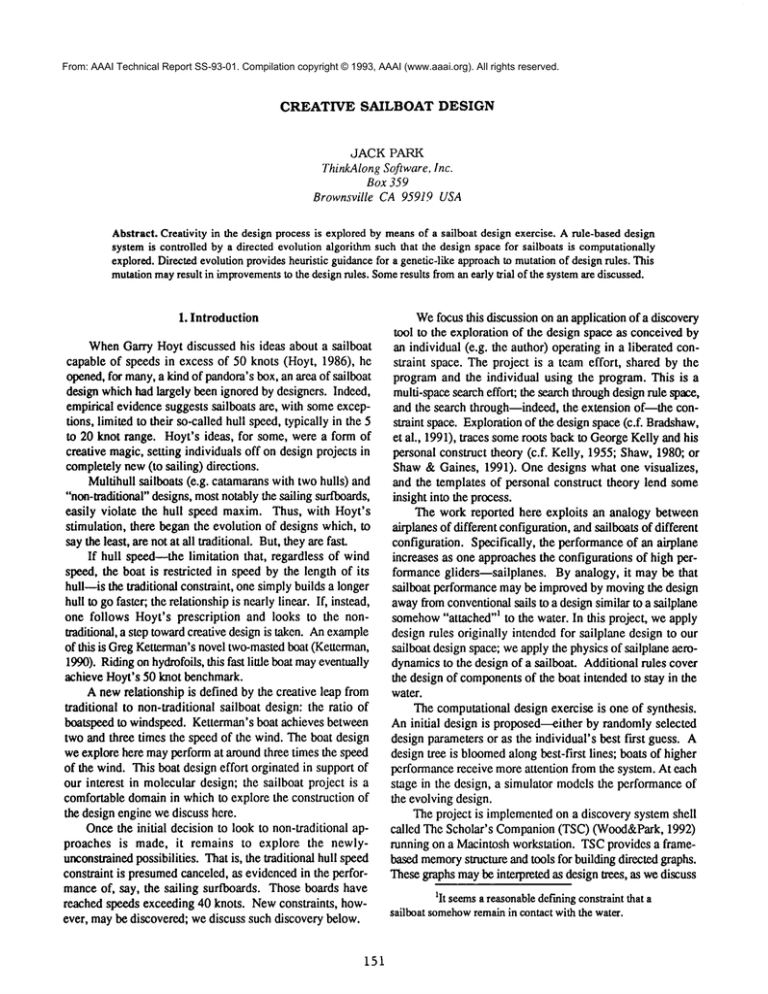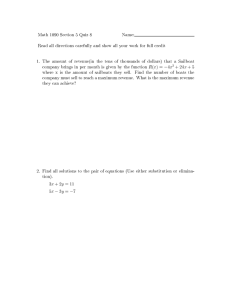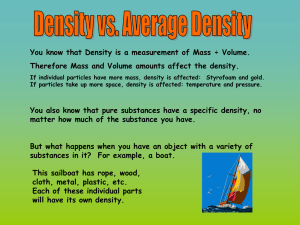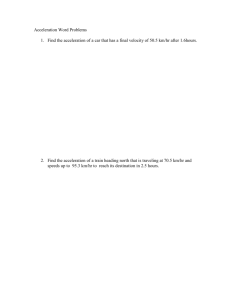
From: AAAI Technical Report SS-93-01. Compilation copyright © 1993, AAAI (www.aaai.org). All rights reserved.
CREATIVE
SAILBOAT
DESIGN
JACK PARK
ThinkAlongSoftware, Inc.
Box 359
Brownsville CA 95919 USA
Abstract.Creativity in the designprocess is exploredby meansof a sailboat design exercise. A rule-based design
systemis controlled by a directed evolutionalgorithmsuch that the design space for sailboats is computationally
explored.Directedevolutionprovidesheuristic guidancefor a genetic-like approachto mutationof designrules. This
mutationmayresult in improvements
to the designrules. Someresults froman early trial of the systemare discussed.
1. Introduction
WhenGarry Hoyt discussed his ideas about a sailboat
capable of speeds in excess of 50 knots (Hoyt, 1986),
opened, for many,a kind of pandora’s box, an area of sailboat
design which had largely been ignored by designers. Indeed,
empirical evidence suggests sailboats are, with someexceptions, limited to their so-called hull speed, typically in the 5
to 20 knot range. Hoyt’s ideas, for some, were a form of
creative magic, setting individuals off on design projects in
completelynew(to sailing) directions.
MultihuUsailboats (e.g. catamarans
with two hulls) and
"non-traditional" designs, mostnotably the sailing surfboards,
easily violate the hull speed maxim. Thus, with Hoyt’s
stimulation, there began the evolution of designs which, to
say the least, are not at all traditional. But, they are fast
If hull speedwthe limitation that, regardless of wind
speed, the boat is restricted in speed by the length of its
hull---is the traditional constraint, one simplybuilds a longer
hull to go faster; the relationship is nearly linear. If, instead,
one follows Hoyt’s prescription and looks to the nontraditional, a step towardcreative design is taken. Anexample
of this is GregKetterman’snovel two-mastedboat (Ketterman,
1990).Ridingon hydrofoils, this fast little boat mayeventually
achieve Hoyt’s 50 knot benchmark.
A newrelationship is defined by the creative leap from
traditional to non-traditional sailboat design: the ratio of
boatspeed to windspeed. Ketterman’s boat achieves between
two and three times the speed of the wind. The boat design
we explore here mayperform at around three times the speed
of the wind. This boat design effort orginated in support of
our interest in molecular design; the sailboat project is a
comfortable domainin which to explore the construction of
the design engine we discuss here.
Oncethe initial decision to look to non-traditional approaches is made, it remains to explore the newlyunconstrainedpossibilities. That is, the traditional hull speed
constraint is presumedcanceled, as evidencedin the performanceof, say, the sailing surfboards. Those boards have
reached speeds exceeding 40 knots. Newconstraints, however, maybe discovered; we discuss such discovery below.
151
Wefocus this discussion on an application of a discovery
tool to the exploration of the design space as conceived by
an individual (e.g. the author) operating in a liberated constraint space. The project is a team effort, shared by the
program and the individual using the program. This is a
multi-spacesearch effort; the search throughdesignrule space,
and the search through--indeed, the extension of---the constraint space. Explorationof the design space (c.f. Bradshaw,
et al., 1991), traces someroots back to GeorgeKelly and his
personal construct theory (c.f. Kelly, 1955; Shaw,1980; or
Shaw & Gaines, 1991). One designs what one visualizes,
and the templates of personal construct theory lend some
insight into the process.
The work reported here exploits an analogy between
airplanes of different configuration, and sailboats of different
configuration. Specifically, the performanceof an airplane
increases as one approachesthe configurations of high performance gliders--sailplanes.
By analogy, it may be that
sailboat performance maybe improved by movingthe design
awayfromconventionalsails to a design similar to a sailplane
somehow
"attached’’1 to the water. In this project, we apply
design rules originally intended for sailplane design to our
sailboat design space; we apply the physics of sailplane aerodynamicsto the design of a sailboat. Additional rules cover
the design of componentsof the boat intended to stay in the
water.
The computational design exercise is one of synthesis.
Aninitial design is proposed---either by randomlyselected
design parameters or as the individual’s best first guess. A
design tree is bloomedalong best-first lines; boats of higher
performancereceive more attention from the system. At each
stage in the design, a simulator models the performance of
the evolving design.
The project is implementedon a discovery system shell
called The Scholar’s Companion(TSC) (Wood&Park,1992)
running on a Macintosh workstation. TSCprovides a framebased memory
structure and tools for building directed graphs.
Thesegraphs maybe interpreted as design trees, as we discuss
lit seemsa reasonabledefiningconstraintthat a
sailboat somehow
remainin contact with the water.
here, or as envisionments---histories of someset of physical
processes. Thus, the TSCgraph tools enable projects in
explanation, prediction, and design. As we illustrate below,
the application of TSCto the exploration of a design space
for a high-speed sailboat uncoversan unanticipated opportunity for explanation and possible discovery.
Wenowlook at the TSCknowledgebase as we apply it
to the design of a high-performancesailboat.
in
If you notice the performance is not improving
in this branch
Then terminate this branch of the design tree
This particular exampleis an instance of a search pruning
rule. As noted by (Navinchandra, 1991), we often do not
want to prune a search for a design since we maytruncate a
path whichleads to an innovative result.
Frame Browser I
Frame(s): Isb.l
0w
5
I¢1¢
Figure 1. TSC design tree.
2. Sailboat design knowledgebase
A TSCknowledgebase consists of several classes of
rules. Someof the rules implementTSC’sbehaviors during
a project. Someof the rules represent someaspect of the
physics of the project. By constructing these physics rules
such that they contribute to the design of a project, design
rules are implemented.An exampledesign rule is:
If you want to improve the performance of the
vehicle
And the vehicle includes an aerodynamic
structure (e.g. a wing)
Then consider increasing wingspan
The initial sailboat design, the first node in the design
tree, initializes all the design parameters. These include
wingspan, boat weight, rudder area, and so forth. A design
cycle involves "firing" design rules on the current (in the
f’wst case, initial) design. Eachrule creates a newnodewith
some small change made to one of the design parameters.
From the example rule above, wingspan would be increased
about ten percent. A simulator is then run on each new
design and the sailboat performance recorded at the node.
In this project, the only performanceparameternoted is maximumspeed of the boat. Since the simulator finds the maximumboat speed at the same windspeed conditions for all
designs, maximum
speed is a convenient comparison value
betweendesigns. Figure 1 illustrates a short exercise of TSC
building a design tree. Nodesalong the top of the illustrated
tree tend to represent the highest performanceboats. A total
of three design rules wereincluded in this run.
TSCincludes a body of rules called "common
sense" or
sense rules. The tree is studied by such rules of the form:
152
Anotherform of sense rule is the "special sense" rule,
the highly specialized rule created specifically for the project.
Included in this group are rules whichanalyze the results of
a simulation and determine if the performance has been improved. Such rules "reward" the design rules which create
the improvedvehicle. A typical reward rule looks like
If a design rule has consistently improved the
performance of the project
Then conjecture that rule will always improve
the performance of the project and give the
rule a small boost in worth
TSCfurther includes a bodyof rules whichdirect learning
and knowledge base improvement. This body also includes
rules whichform hypotheses, study hypotheses, collect data,
and so forth. Theserules play an importantrole in the act of
design creativity since they maybe directed at the design
process itself. As we discuss below, creativity occasionally
involves "breaking the rules." This maybe done either by
some random rule mutation process, such as in a Genetic
Algorithm (Holland, 1992), or by heuristic mutation means.
Formation of hypotheses centered on rule mutations becomesan interesting area of research related to computational
creativity. Wenowbriefly look at creativity as it relates to
this design project.
3. ComputationalCreativity
Anearly benchmarkfor discussion of creativity has been
the 4-step modelof creativity due to (Wallas, 1926): preparation, incubation, illumination, and sum-up. The individual
involved in design work of this nature is responsible for
preparation and incubation, while TSCassists in incubation
and illumination by conductinga search through design space.
60
s5
50 ....
45
40
.
::::
III
¯ ,,
25 _ ::::
: : : :
: : : :
!::
:::::
;
i
...
]!!
¯ ,.
: : : :
:::
’’’
::::
-11111
: : : :
I
li ....
If ....
J
:1111
,,,
III
O
: : : :
JJ .....
"NI
30 : ....
lO
: : : :
Ill ......
iii .....
::::
35 : ::::
20
I I I I I
: : : :
: : : :
"Nil
ill!
it
ii1::
::::
.....
iiii ’ iiii ’
IIII
;:::
:::::
.....
i
I
IIIli
illll
illll
J
: : : : ;
.....
: : : : :
::::
I,
::;:
..... IIIII
::::
if
ilX
::::
’’’"~¯
II
Figure2. Speedvs. net forwardthrust
The individual then performs any sum-uprequired to execute
a final boat design. Occasionally, the combination of computational and humanintellect being applied to a design task
illuminates someaspect of the design not anticipated at the
outset.
One acquires, through rote and experiential learning, a
corpus of design rules. These rules allow one to mapgoals
to ideas and concepts. A body of such rules in an expert
system does an adequate job of taking an initial design and
mutating it until somegoal is met. This is a direct analog to
optimization.
Webelieve an important aspect of creativity is missing
from the expert design system. Creativity, we suspect, often
means"breaking the rules." The Wallas 4-step modelprovides
a convenient"outer loop" but, often as not, we simply ignore
some constraint and plow on as though trying to escape
somelocal minimum--hill climbing to reach a design goal.
The results of this are occasionally useless, but also occasionally quite useful. The TSCarchitecture encourages
mutation of rules such that the design search space is potentially expanded. The source of creative power in the TSC
systemis its rule mutationsystem, runningunderthe direction
of directed evolution2. Directed evolution is a mix of genetic
algorithm and heuristic guidance.
Breakingthe rules involves machinelearning approaches
to design rule mutation. In the next section, we describe
two related projects whichmotivate the workdescribed here.
~Theterm is borrowedfrommolecularbiology
(Abelsor~
1990).
153
4. Related Work
Muchof this work is inspired by the work of Douglas
Lenat (Lenat et al., 1982) and by the work of Peter Karp
(Karp, 1990). Lenat’s work deals with the generation
design alternatives in the domainof VLSI. In his Eurisko
program, Lenat applies heuristic rules to the combination
and mutation of other rules. This rule mutation scheme
provides an opportunity to explore notions of computational
creativity.
Karp’s work deals with the formation of hypotheses in
the domain of molecular biology. His approach to the hypotheses formation based on analysis of experiments is directly applicable to the design work discussed here. As a
design tree evolves, analysis of the ongoingresults presents
opportunities for hypothesis formation, rule mutation, and
design creativity. Wehave explored other aspects of the
hypothesis formation task in an immunesystem response
project (Park & Wood,1992).
5. Results and Discussion
Figure 2 illustrates one of the designs explored by TSC.
The plot showsthe relationship between net forward thrust
and boat speed for a 20 mph wind speed. The concave
downward
curve satisfies our intuitions that the faster the
boat travels, the less surplus thrust it will haveto accelerate.
Ideally, one reads the maximumspeed as the point where
the curve crosses the x-axis.
The curve offers a pair of interesting points worth pon-
dering: two discontinuities are noted. The upper left---occuring at low speed--is easily explained by the boat lifting a
balance ski out of the water whenit is no longer needed to
maintain, as sailors would say, an even keel. The second
discontinuity 3, occuring at muchhigher speed, is a bit more
interesting. In fact, the author found this second point an
inspiration for discovery: design rules to keepthe boat in the
water. In fact, the problemof the boat lifting clear of the
water remains a partially unsolved problemat this writing;
the effective maximum
speed of the boat is therefore the
speedat whichit tries to fly. The problemsuggests a counterintuitive solution: the heavierthe boat, the faster it can go.
Every aspect of the design tool discussed, except the
rule mutationactivity, has been implemented
for this project.
Rule mutation has been implementedin a project on protein
structure (LeClair et al., 1992). It remains to integrate all
the tools.
6. Summary& conclusion
Wehave illuminated an architecture we are implementing
for design. The project used as the trial case is that of a
high-speed sailboat. By mappingknowledgefrom the domain
of sailplanes to the domainof sailboats, we introduce new
performancecriteria to boats--boat-to-windspeedratio---and
we introduce opportunities for new (at least, new to the
author) discoveries.
~l~eseare, indeed,discontinuities,masked
by the
curveplotter used.
Acknowldegements.
This project has benefitted greatly fromthe
workof manyothers. In additionto the workersnotedabove.,
we happily acknowledgeproductive conversations and help
fromDanWood,Steve [.eClair, Scott King, and DaveFoster.
7. References
Abelson,John, "DirectedEvolutionof NucleicAcidsby Independent
Replicationand Selection," Science 249, 3 August,1990, pp
488-489.
Bradshaw,Jeffrey M., DavidSherna, and JohnH. Boose,"Canard:
AnAlternative GenerationToolBasedon Possibility Tables,"
in Creativity: Models,Methods,andTools, 1991, AAAI.
Holland,JohnH., Adaptationin Naturaland Artificial Systems,
1992, CambridgeMA,The MITPress.
Hoyt, Garry, READY
ABOUT!
, 1986, Camden
Maine,International
MarinePublishingCo.
Karp,Peter D., "HypothesisFormationas Design,"in Jeff Shrager
and Pat Langley, eds., Computational
Modelsof Scientific
Discoveryand TheoryFormation,1990, San Mateo,CA,Morgan Kaufmann.
Kelly, G.A., The Psychologyof PersonalConstructs, 1955, New
York,Norton.
Ketterman,Greg, "Experiments
in High-Speed
Sailing: TriFoiler,"
Multihulls, May/June
1990, pp 63-65.
LeClair, Steven R., Scott King, DanWood
and Jack Park, "Using
A Directed Evolution SystemTo Predict Protein Secondary
Structure," 1992,manuscriptin preparation.
Lenat, DouglasB., WilliamR. Sutherland, and JamesGibbons,
"Heuristic Search for NewMicrocircuit Structures: AnApplication of Artificial Intelligence,"TheAI Magazine,
Summer,
1982.
Navinchandra,
D., "InnovativeDesignby Exploration,"in Creativit2/: Models,Methods,andTools, 1991,AAAI.
Park, Jack, and DanWood,"Getting the ModelRight: Couplinga
Cellular Automatato a DiscoverySystem,"in Jan M. Zytkow,
editor, Proceedingsof the ML92Workshopon MachineDiscovery, 1992, Aberdeen,Scotland, Universityof Aberdeen.
Shaw,Mildred L.G., and Brian R. Gaines, "MappingCreativity
with Knowledge
SupportTools," in Creativity: Models,Methods, and Tools, 1991, AAAI.
Shaw,M.L.G,OnBecominga PersonalScientist: Interactive Computer Elicitation of PersonalModelsof the World,1980,London, Wiley.
Wallas, G., TheArt of Though~1926, NewYork,Harcourt.
Wood,Dan, and Jack Park,User’sManualfor The Scholar’s Companion, 1992, Brownsville,CA,ThinkAlong
Software.
154







